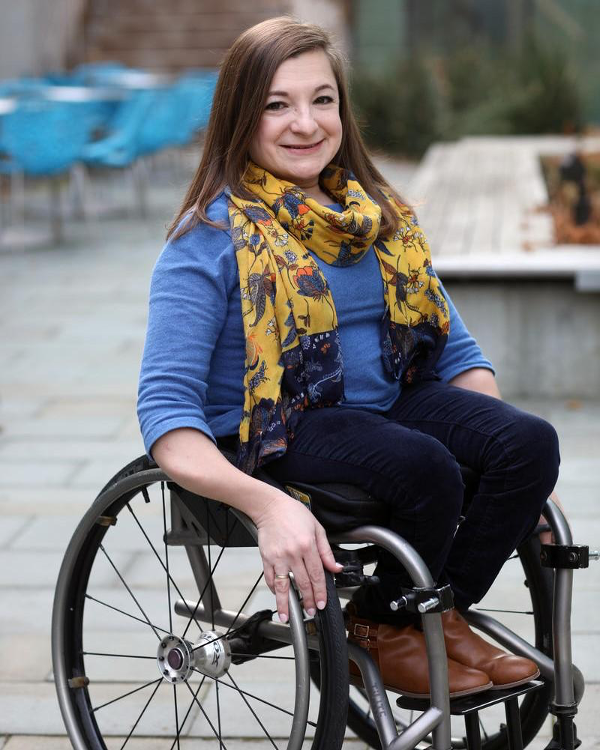“I, like a lot of advocates, don’t have this urgency to go back to normal, because normal, in many ways, wasn’t great for our disability community.”

Dr. Kara Ayers
There is mounting evidence that people with intellectual and developmental disabilities (IDD) are experiencing more severe COVID-19 outcomes than the general population. In many ways, vaccination is a golden opportunity to address longstanding issues of equity and injustice. Our guest, Dr. Kara Ayers, PhD, is here to help us explore just how true that is for people with disabilities. Dr. Ayers is the Associate Director of the University of Cincinnati Center for Excellence in Developmental Disabilities, and the co-founder of the Disabled Parenting Project.
Living with Disabilities during COVID-19
People living with disabilities already faced unique challenges to their physical and mental health before the COVID-19 pandemic hit. There is mounting evidence that the disability community has been disproportionately impacted by this pandemic, including higher case rates and case fatality rates. Dr. Ayers, who is herself a proud disabled woman and is high-risk should she acquire COVID, shared about her lived experience over the last 15 months: “My lungs have a harder time fighting off respiratory infections, as does my husband who has the same condition,” Dr. Ayers explained. “I had a lot of sleepless nights worried about what would happen if one or both of us got sick and what would happen to our three kids.”
Already accustomed to living with anxiety because of her disability, osteogenesis imperfecta, which makes her bones more susceptible to breaking, Dr. Ayers says that the added stress of COVID made the last many months even more challenging.
Returning to “Normal”
“My perspective has definitely changed since pre-COVID in terms of what priorities I have. I am definitely committed to taking some of these lessons learned and not just losing them,” says Dr. Ayers. “I, like a lot of advocates, don’t have this urgency to go back to normal, because normal, in many ways, wasn’t great for our disability community.” Transportation barriers, for example, and social isolation were already in place for the disability community long before the pandemic, which may be why some studies have shown greater resilience and coping skills during the pandemic among those with disabilities—because they were already experiencing many aspects of what life became like for millions during the pandemic.
Other challenges facing the disability community, like the direct support provider crisis, were exacerbated by the pandemic. Dr. Ayers says she heard from many people living with disabilities who said their caregivers stopped showing up during the pandemic to avoid infection—an understandable precaution but one that leaves a person with a disability unable to meet their own daily basic needs.
Even harder to document, but still impactful, is “the dialogue that society started having and, in many ways, didn’t stop having, that only the sick or the old would die,” Dr. Ayers says. She reflects on the impact of seeing so many people seem fine with that expenditure during the pandemic. “I think that, for many of us, including myself, is a deep wound that will take—I’m not sure, what amount of time, or what, to heal,” says Dr. Ayers.
Vaccine Frustration & Uptake in the IDD Community
When vaccines became available earlier this year, Dr. Ayers was frustrated to find that, though it was clear that vulnerable populations like the elderly or those with disabilities were more likely to have negative COVID-19 outcomes, they failed to prioritize these populations when it came to vaccine distribution.
One of the projects Dr. Ayers worked on was a dashboard that allowed people to see how they were prioritized as a person with a disability in their state. “We tried to assist in making sense of a lot of confusing messages,” says Dr. Ayers.
When it comes to vaccine uptake among those who live with IDD, Dr. Ayers says we still do not have a clear picture of how it is going. This is because no state has done a good job gathering disability data surrounding vaccination. Most states rely on data from those who are registered with the state’s IDD services. Unfortunately, only about 20-25 percent of people with IDD in any state are connected to their state’s IDD services. For those who are motivated to get their vaccines, there are still plenty of barriers in place. Dr. Ayers says that ways to make the experience as accessible as possible include spreading accurate information about what to expect at a vaccination site and to ensure that all efforts to get people vaccinated are meeting the needs of the communities themselves.
“I hope we keep healing as a society,” says Dr. Ayers. “I think part of our healing is conversations like this.”
